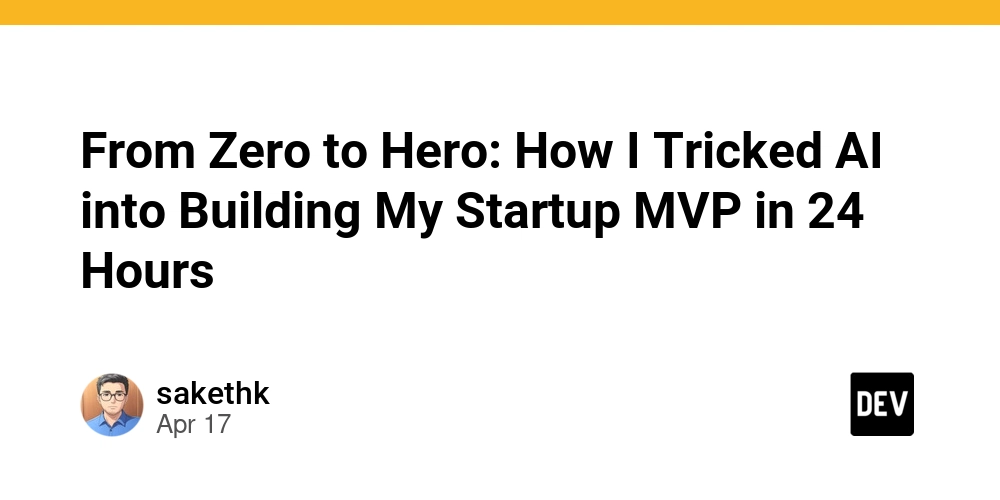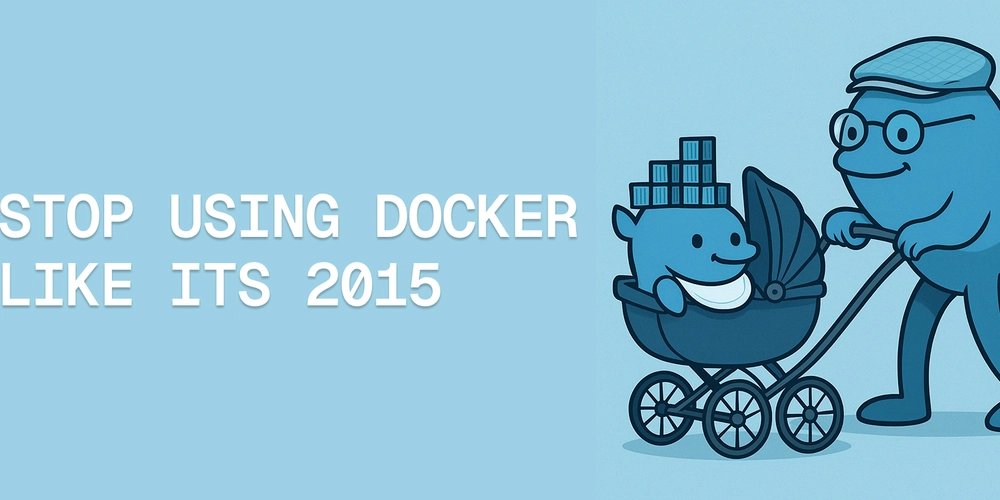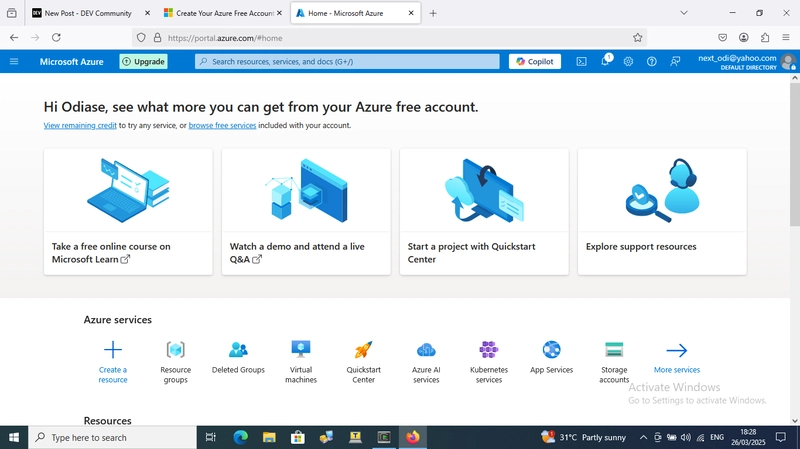From Zero to Hero: How I Tricked AI into Building My Startup MVP in 24 Hours
Hey there, fellow code warriors and startup dreamers! Grab your favorite caffeinated beverage, because I'm about to spill the beans on how I pulled off the ultimate developer heist: building a startup MVP in just 24 hours using AI tools. Spoiler alert: no coffee beans were harmed in the making of this MVP, but my sleep schedule? That's another story. The Lightbulb Moment It all started on a regular Tuesday night. I was knee-deep in my fifth coding tutorial of the day when it hit me – an idea so brilliant, it made my LED desk lamp look dim in comparison. I wanted to create a platform that matches developers with mentors based on their coding style and personality. Think Tinder, but for finding your coding soulmate. The problem? I had exactly 24 hours before a big pitch event. The solution? Embrace the AI revolution and see just how far these digital minions could take me. The AI Toolkit: My Digital Dream Team Before we dive in, let me introduce you to my AI squad: ChatGPT: My go-to for brainstorming, code snippets, and witty commit messages. GitHub Copilot: The Robin to my Batman in the IDE. Midjourney: For whipping up some fancy graphics without selling my soul to Photoshop. Otter.ai: To transcribe my caffeine-fueled 3 AM ramblings into coherent documentation. Now, let's break down how I turned 24 hours into startup gold. Hour 0-2: Planning and Design First things first, I needed a game plan. I fired up ChatGPT and asked it to help me break down my idea into manageable chunks. We brainstormed features, user flows, and even came up with a name: "CodeMate" (I know, I know, but cut me some slack – it was 2 AM). Next, I used Midjourney to generate some quick mockups. Was it perfect? No. Did it look better than anything I could draw with my sleep-deprived hands? Absolutely. Hour 2-8: Backend Sorcery With a plan in hand, it was time to tackle the backend. I chose Node.js (because JavaScript is life) and MongoDB (because who has time for schemas?). GitHub Copilot became my best friend here. It was like pair programming with a robot that never needed coffee breaks. We set up the basic server structure, API endpoints, and database connections faster than you can say "npm install". Here's a snippet of how Copilot helped me whip up an endpoint: app.post('/api/match', async (req, res) => { try { const { userId, preferences } = req.body; // Copilot suggested this clever matching algorithm const potentialMentors = await User.find({ skillset: { $in: preferences.skills }, availability: { $gte: preferences.minHours } }).sort({ rating: -1 }).limit(5); res.json({ matches: potentialMentors }); } catch (error) { res.status(500).json({ error: 'Oops, the matchmaker took a coffee break' }); } }); Was it perfect? Nope. Did it work? You bet your last semicolon it did. Hour 8-16: Frontend Frenzy With the backend humming along, it was time to make this thing look pretty. I opted for React because, let's face it, I'm basic like that. ChatGPT helped me structure my components, while Copilot filled in the gaps. We created a slick matching interface, complete with swipe animations (because if you're not swiping in 2023, are you even living?). The real MVP of the frontend marathon? This little CSS trick ChatGPT taught me: .match-card { transition: transform 0.3s ease; } .match-card:hover { transform: translateY(-5px) rotate(2deg); } Subtle? Yes. Did it make me feel like a CSS god? Also yes. Hour 16-20: Integration and Testing With both ends of my digital masterpiece ready, it was time for the dreaded integration. I won't lie – there were moments when I considered pivoting to a career in goat farming. But then, a miracle happened. Everything just... worked. Okay, not everything. But enough that I could demo without bursting into tears. I used Otter.ai to dictate some quick test cases while I manually clicked around like a caffeinated squirrel. It wasn't thorough, but it was enough to catch the "oops, I forgot to handle null inputs" kind of bugs. Hour 20-23: Polishing and Pitching With a functional MVP in hand, it was time to make this thing shine. I used Midjourney to create a logo that looked like it cost way more than zero dollars, and ChatGPT helped me craft a pitch that would make even the most jaded VC's heart flutter. Hour 23-24: The Home Stretch In the final hour, fueled by a dangerous mix of energy drinks and sheer panic, I deployed my creation to the cloud. As the loading bar inched towards 100%, I swear I heard the "Chariots of Fire" theme playing softly in the background. And just like that, with minutes to spare, CodeMate was born. The Aftermath Did I revolutionize the tech industry in 24 hours? Probably not. Did I create a functional MVP that impressed the pants off the pitch event judges? You bet your last git push I did. The moral of the

Hey there, fellow code warriors and startup dreamers! Grab your favorite caffeinated beverage, because I'm about to spill the beans on how I pulled off the ultimate developer heist: building a startup MVP in just 24 hours using AI tools. Spoiler alert: no coffee beans were harmed in the making of this MVP, but my sleep schedule? That's another story.
The Lightbulb Moment
It all started on a regular Tuesday night. I was knee-deep in my fifth coding tutorial of the day when it hit me – an idea so brilliant, it made my LED desk lamp look dim in comparison. I wanted to create a platform that matches developers with mentors based on their coding style and personality. Think Tinder, but for finding your coding soulmate.
The problem? I had exactly 24 hours before a big pitch event. The solution? Embrace the AI revolution and see just how far these digital minions could take me.
The AI Toolkit: My Digital Dream Team
Before we dive in, let me introduce you to my AI squad:
- ChatGPT: My go-to for brainstorming, code snippets, and witty commit messages.
- GitHub Copilot: The Robin to my Batman in the IDE.
- Midjourney: For whipping up some fancy graphics without selling my soul to Photoshop.
- Otter.ai: To transcribe my caffeine-fueled 3 AM ramblings into coherent documentation.
Now, let's break down how I turned 24 hours into startup gold.
Hour 0-2: Planning and Design
First things first, I needed a game plan. I fired up ChatGPT and asked it to help me break down my idea into manageable chunks. We brainstormed features, user flows, and even came up with a name: "CodeMate" (I know, I know, but cut me some slack – it was 2 AM).
Next, I used Midjourney to generate some quick mockups. Was it perfect? No. Did it look better than anything I could draw with my sleep-deprived hands? Absolutely.
Hour 2-8: Backend Sorcery
With a plan in hand, it was time to tackle the backend. I chose Node.js (because JavaScript is life) and MongoDB (because who has time for schemas?).
GitHub Copilot became my best friend here. It was like pair programming with a robot that never needed coffee breaks. We set up the basic server structure, API endpoints, and database connections faster than you can say "npm install".
Here's a snippet of how Copilot helped me whip up an endpoint:
app.post('/api/match', async (req, res) => {
try {
const { userId, preferences } = req.body;
// Copilot suggested this clever matching algorithm
const potentialMentors = await User.find({
skillset: { $in: preferences.skills },
availability: { $gte: preferences.minHours }
}).sort({ rating: -1 }).limit(5);
res.json({ matches: potentialMentors });
} catch (error) {
res.status(500).json({ error: 'Oops, the matchmaker took a coffee break' });
}
});
Was it perfect? Nope. Did it work? You bet your last semicolon it did.
Hour 8-16: Frontend Frenzy
With the backend humming along, it was time to make this thing look pretty. I opted for React because, let's face it, I'm basic like that.
ChatGPT helped me structure my components, while Copilot filled in the gaps. We created a slick matching interface, complete with swipe animations (because if you're not swiping in 2023, are you even living?).
The real MVP of the frontend marathon? This little CSS trick ChatGPT taught me:
.match-card {
transition: transform 0.3s ease;
}
.match-card:hover {
transform: translateY(-5px) rotate(2deg);
}
Subtle? Yes. Did it make me feel like a CSS god? Also yes.
Hour 16-20: Integration and Testing
With both ends of my digital masterpiece ready, it was time for the dreaded integration. I won't lie – there were moments when I considered pivoting to a career in goat farming.
But then, a miracle happened. Everything just... worked. Okay, not everything. But enough that I could demo without bursting into tears.
I used Otter.ai to dictate some quick test cases while I manually clicked around like a caffeinated squirrel. It wasn't thorough, but it was enough to catch the "oops, I forgot to handle null inputs" kind of bugs.
Hour 20-23: Polishing and Pitching
With a functional MVP in hand, it was time to make this thing shine. I used Midjourney to create a logo that looked like it cost way more than zero dollars, and ChatGPT helped me craft a pitch that would make even the most jaded VC's heart flutter.
Hour 23-24: The Home Stretch
In the final hour, fueled by a dangerous mix of energy drinks and sheer panic, I deployed my creation to the cloud. As the loading bar inched towards 100%, I swear I heard the "Chariots of Fire" theme playing softly in the background.
And just like that, with minutes to spare, CodeMate was born.
The Aftermath
Did I revolutionize the tech industry in 24 hours? Probably not. Did I create a functional MVP that impressed the pants off the pitch event judges? You bet your last git push I did.
The moral of the story? AI tools are incredible, but they're not magic. They're more like really smart assistants who never sleep and occasionally try to gaslight you into using tabs instead of spaces.
So, fellow developers, embrace the AI revolution. Let these digital minions handle the grunt work while you focus on the big picture. Who knows? Your next 24-hour coding bender might just birth the next big thing.
And remember, in the wise words of a sleep-deprived developer (me): "If at first you don't succeed, try, try again. If that doesn't work, ask ChatGPT."
Follow me for more tales of coding adventures and occasional cries for help. And if you see me at a hackathon, please bring coffee. Or a pillow. Or both.




























![[Webinar] AI Is Already Inside Your SaaS Stack — Learn How to Prevent the Next Silent Breach](https://blogger.googleusercontent.com/img/b/R29vZ2xl/AVvXsEiOWn65wd33dg2uO99NrtKbpYLfcepwOLidQDMls0HXKlA91k6HURluRA4WXgJRAZldEe1VReMQZyyYt1PgnoAn5JPpILsWlXIzmrBSs_TBoyPwO7hZrWouBg2-O3mdeoeSGY-l9_bsZB7vbpKjTSvG93zNytjxgTaMPqo9iq9Z5pGa05CJOs9uXpwHFT4/s1600/ai-cyber.jpg?#)














































































































































![[The AI Show Episode 144]: ChatGPT’s New Memory, Shopify CEO’s Leaked “AI First” Memo, Google Cloud Next Releases, o3 and o4-mini Coming Soon & Llama 4’s Rocky Launch](https://www.marketingaiinstitute.com/hubfs/ep%20144%20cover.png)




































































































































































































![Rogue Company Elite tier list of best characters [April 2025]](https://media.pocketgamer.com/artwork/na-33136-1657102075/rogue-company-ios-android-tier-cover.jpg?#)








































































_Andreas_Prott_Alamy.jpg?width=1280&auto=webp&quality=80&disable=upscale#)




























































































![What’s new in Android’s April 2025 Google System Updates [U: 4/18]](https://i0.wp.com/9to5google.com/wp-content/uploads/sites/4/2025/01/google-play-services-3.jpg?resize=1200%2C628&quality=82&strip=all&ssl=1)










![Apple Watch Series 10 Back On Sale for $299! [Lowest Price Ever]](https://www.iclarified.com/images/news/96657/96657/96657-640.jpg)
![EU Postpones Apple App Store Fines Amid Tariff Negotiations [Report]](https://www.iclarified.com/images/news/97068/97068/97068-640.jpg)
![Apple Slips to Fifth in China's Smartphone Market with 9% Decline [Report]](https://www.iclarified.com/images/news/97065/97065/97065-640.jpg)



































































































































